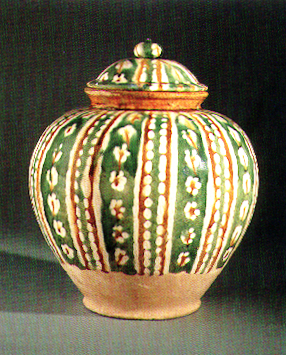
Tang Dynasty lidded jar, Earthenware with sancai glazing
China, 750 CE, 10" height
ART 198 - HISTORY OF WORLD CERAMICS
| The Tang Dynasty of China lasted from 618-906 CE and was a time of trade and prosperity for the Chinese. A trade route, the 'silk road,' allowed goods to be exchanged as far west as Iran and sea routes were opened to India, Japan, and Indonesia, and the Chinese were exposed to many foreign influences from the traders that passed through their land. Ceramic materials were imported, including a lead frit used to prepare the glazes on earthenware of the period The glazing style is often referred to as sancai (literally, 'three colors'), consisting of a clear glaze, an amber to brown glaze made using iron oxide, and a bright green colored glaze prepared using copper oxide. Rarely, cobalt oxide was used, for a brilliant blue. Sancai glazing was used on large figures of people and horses, and these are well known, but the technique was also used on funeral vessels such as this lidded jar. Lead glazes were known to be poisonous, so their use was restricted to sculptural forms and funeral ware. This jar has a pattern of stripes and flowers, and may be borrowed from the patterns used in the painted silk batiks of Indonesia. This shape, called 'Wannian' (which means 'myriad year') was a preferred one for burial ware. | Tang Dynasty lidded jar, Earthenware with sancai glazing China, 750 CE, 10" height |
|
|